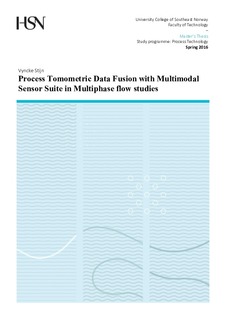| dc.description.abstract | The objective of the thesis is to propose simple tests on raw electrical measurements, using electrical capacitance tomography in order to assess the prevailing flow regime in the test section.
This information regarding the flow patterns is useful in itself in many scientific applications: it can be used in computing fluid dynamics (CFD) for fine-tuning the input parameters, increasing safety on site by providing information about dangerous flow patterns such as slug. In electrical tomography, the reconstruction of an image from the electrical measurements is greatly enhanced when one can postulate what approximately the test area looks like in real time (i.e. flow patterns). By using the raw data coming from the sensor, we avoided the image processing and proposed criteria for different flow patterns.
Fang and Cumberbatch have proposed to analyse the eigenvalues of the capacitance data matrix in order to identify core annular or stratified flows. They argue that the analysis of eigenvalues collapses the amount of data to be processed and has the advantage that the analysis is rotationally invariant. Their study has been completely based on numerical simulations of the response of an electrical capacitance tomography (ECT) sensor.
Based on their work, we have considered the analysis of eigenvalues of the capacitance matrix but obtained the test criteria based on experimental data, gathered during measurement sessions. We have focused on flow regimes occurring in horizontal pipes. Our tests somewhat differ from Fang and Cumberbatch. One criterion differentiates intermittent flows (plug and slug) form static flows (stratified, wavy and annular) based on the standard deviation of the time series set of the capacitance measurements. The second criterion differentiates annular flows from layered flows (stratified and wavy).
For intermittent flows, we found another criterion using the gamma-ray sensor. A Fast Fourier Transform (FFT) was applied on the time series. This gave us the frequency of plugs and slug. Due to this criterion, we can identify intermittent flows. | nb_NO |
